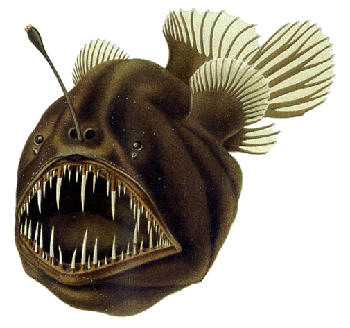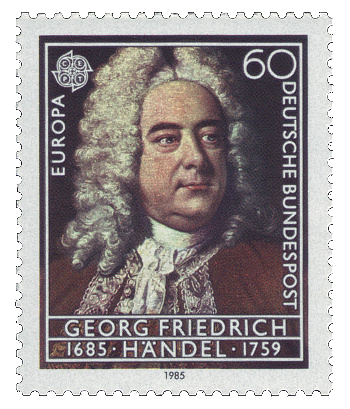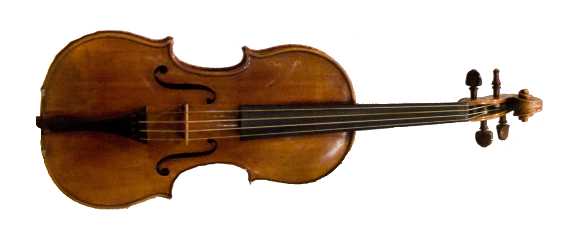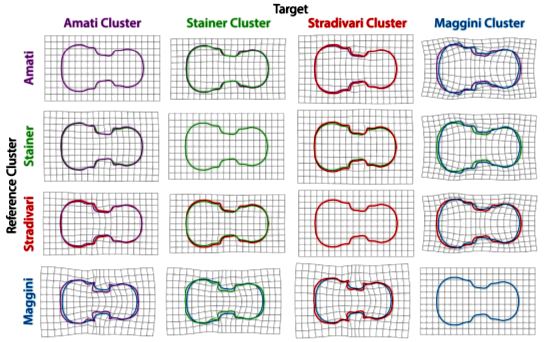Violin Evolution
October 31, 2014
Nature, through
evolutionary processes, has been changing and "
forking" the body plans of
organisms since the emergence, about 3.5 billion years ago, of
life on Earth. Everywhere there's an
ecological niche, nature tries to fill it, sometimes with unusual organisms, such as those discovered in the
depths of the sea (see drawing).

The Humpback anglerfish (Melanocetus johnsonii), a species of the aptly named black seadevil (Melanocetidae).
This fish is found at sea depths of up to 6,600 feet (2 kilometers).
(Via Wikimedia Commons.)
It's possible that the
evolution of the human hand was affected by our tool use, starting with the
primitive tools we used in the
Lower Paleolithic, 2.5 million years ago.[1-2] Our present toolmaking has been more refined, and we've adapted the tools to better serve us, rather than the other way around. Tools have evolved to better fulfill their purpose.
Hand tools now have curved
handles, and they are made from
lightweight materials. The
battery-powered,
electric screwdriver has likely saved many a
craftsman from
carpal tunnel syndrome.
Many years ago, I discovered the
niche of
classical music being played on
instruments of the same period at which the music was
composed. Most of these compositions are now played on
modern instruments; but, to hear them as their
composers did, they need to be played on the instruments of the composer's era. My transient obsession started with versions of
Handel's "
Water Music," and it advanced to
Medieval music. Perhaps this was
subconsciously triggered by my watching the
The Adventures of Robin Hood television series as a
young child.

George Frideric Handel as he appears on a 1985 German postage stamp.
1985 was the 300th anniversary of Handel's birth, and the birth of Johann Sebastian Bach.
I recommend the recordings of the Academy of Ancient Music for those interested in early music.
(Via Wikimedia Commons.)[3-4)]
Most people are familiar with such early instruments as the
harpsichord, and the
lute, an early form of the
guitar; but, how many have heard a
sackbut? The sackbut is an early form of the
trombone, common in both
Renaissance music and
Baroque music. It's similar to the trombone, since it's a
brass horn with a
telescopic slide, but today's trombone has evolved improvements, such as a larger
bore and an extended
bell, both of which increase
loudness, and a
tuning slide.
It's obvious that
stringed instruments evolved in size in order to access different parts of the
audio frequency spectrum; i.e., the large
double bass is used to play the
very low frequency notes, down to about 31
Hz. There's a wide range of size of instruments in the
violin family, but within members of the family, itself, there was an evolution of instrument shape. A study of the
morphological evolution of the violin has recently been
published as an
open access article in
PLoS ONE.[5-6]
The first violins were made in
16th century Italy, and their design changed to improve their acoustical properties and playability. There was likely considerable input from
musicians, themselves, as to what an ideal instrument should be, and there are some details of the violin shape that relate merely to
aesthetics and not to sound quality. Such aesthetic elements were more likely to change as
historical tastes changed. An interesting object of study would be how
luthiers, as violin-makers are called, influenced each other.[5-6]
Dan Chitwood, a
plant biologist, is an assistant member of the
Donald Danforth Plant Science Center,
St. Louis, Missouri, where he does
research on plant morphology; specifically, the study of
leaf shape, its relation to plant viability, and how it has evolved to allow plants to adapt to certain
environments. One example of this is a
desert-
adapted tomato species that can survive with little
water because of its particular leaf architecture. Chitwood is also a
viola player, so he applied his morphological tools to the evolution of violin shape.[6]

A Stadivarius violin, restored to playable condition, at the National Music Museum in Vermillion, South Dakota. (Portion of a photograph by Larry Jacobsen, via Wikimedia Commons.)
Says Chitwood,
"There are many parallels between leaves and violins... Both have beautiful shapes that are potentially functional, change over time, or result from mimicry. Shape is information that can tell us a story. Just as evolutionary changes in leaf shape inform us about mechanisms that ultimately determine plant morphology, the analysis of cultural innovations, such as violins, gives us a glimpse into the historical forces shaping our lives and creativity."[6]
Chitwood built a
dataset of the shape of more than 9,000 violins, built over the course of 400 years, from
auction house images.[5-6] Among the luthiers represented were
Giovanni Paolo Maggini,
Giuseppe Guarneri del Gesù, and
Antonio Stradivari. There were also luthiers who copied Stradivari. These were
Nicolas Lupot,
Vincenzo Panormo, and
Jean-Baptiste Vuillaume.[6]
Chitwood's
linear discriminant analysis corroborated historical accounts of who copied whom. The analysis also demonstrated that four discrete shapes predominated in most instruments and the widespread imitation and the transmission of design (see figure).[5] Says Chitwood, “This is a fantastic example of how advances in one field can help advance a seemingly unrelated field."[6]

Thin plate splines of major violin clusters. The differences have been amplified by a factor of four for better visualization. (Fig. 7 of ref. 5.)[5)]
References:
- Matthew W. Tocheri, Caley M. Orr, Marc C. Jacofsky, and Mary W. Marzke, "The Evolutionary History of the Hominin Hand since the Last Common Ancestor of Pan and Homo," Journal of Anatomy, vol. 212, no. 4 (April, 2008), pp. 544-562. A PDF file is available here.
- Irving Wladawsky-Berger, "The Co-Evolution of Humans and our Tools," Irving Wladawsky-Berger Blog, March 7, 2011.
- Academy Of Ancient Music Web Site.
- 1 - Hour of Early Middle Ages Music, YouTube Video.
- Daniel H. Chitwood, "Imitation, Genetic Lineages, and Time Influenced the Morphological Evolution of the Violin," PLoS ONE, vol. 9, no. 10 (October 8, 2014), Document No. e109229, doi:10.1371/journal.pone.0109229. This is an Open Access Publication with a PDF file available here.
- Plant scientist discovers basis of evolution in violins, Donald Danforth Plant Science Center Press Release, October 8, 2014.
Permanent Link to this article
Linked Keywords: Nature; evolution; evolutionary process; fork; organism; life on Earth; ecological niche; abyssal zone; depths of the sea; Humpback anglerfish; foot; kilometer; Wikimedia Commons; evolution of the human hand; stone tool; primitive tool; Lower Paleolithic; hand tool; grip; handle; weight; lightweight; material; battery-powered; electric screwdriver; craft; craftsman; carpal tunnel syndrome; niche; classical music; musical instrument; composer; compose; modern history; George Frideric Handel; Water Music; Medieval music; subconscious; The Adventures of Robin Hood; young child; Johann Sebastian Bach; Academy of Ancient Music; harpsichord; lute; guitar; sackbut; trombone; Renaissance music; Baroque music; brass; horn; telescopic; bore; bell; loudness; tuning; stringed instrument; audio frequency; frequency spectrum; double bass; low frequency note; hertz; Hz; violin family; mathematical morphology; morphological; scientific literature; open-access journal; open access article; PLoS ONE; 16th century; Italy; musician; aesthetics; history; historical; luthier; Dan Chitwood; botany; plant biologist; Donald Danforth Plant Science Center; St. Louis, Missouri; research; leaf; environment; desert; adaptation; adapt; tomato; species; water; viola; Stadivarius; National Music Museum; Vermillion, South Dakota; dataset; auction house; Giovanni Paolo Maggini; Giuseppe Guarneri del Gesù; Antonio Stradivari; Nicolas Lupot; Vincenzo Panormo; Jean-Baptiste Vuillaume; linear discriminant analysis; spline; infographic; visualization.